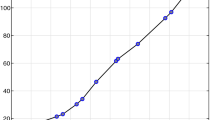Summary
This paper discusses the problem of detecting the trend-cycle of economic time series (x t), using frequency-domain arguments which lead to an analytical approach focusing on optimal filter design.
After providing an unambiguous characterization of the components-i.e., trend (f t), cycle (c t), seasonality (s t) and error term (η1)-, a time-domain model is proposed as follows:
wherec (e ν)t ands (e ν)t denote evolving cyclic and seasonal components, respectively. Based on the time-domain characterization of components and assuming amplitude-modulation-like mechanisms for the evolutive behaviours, a one-to-one correspondence is established between trend, cycle, seasonality and well defined low, intermediate and high frequency bands, respectively. Furthermore assuming that the error term is generated by a zero-mean harmonizable process, it follows the existence of a frequency-domain representation of this component that covers the whole frequency range. Hence, a complete characterization of the series along the frequency axis is obtained, and the problem of extracting the trend-cycle component from the series takes on the form of a (low-pass) filtering problem.
The question of finding the appropriate linear filter for trend-cycle estimation is addressed by specifying the set of requirements to be fulfilled by the filter transfer function and impulse response, which eventually leads to a constrained-optimization-based approach to the problem. Parsimony-oriented solutions to the problem are then proposed and their performances highlighted with a few examples.
Similar content being viewed by others
References
Akaike, H. (1980), Seasonal adjustment by a Bayesian modeling,Journal of Time Series Analysis, 1, 1–13.
Bongard, J. (1963), L'élimination des variations saisonnières par la méthode des modèles mobiles,Informations Statistiques, I, 63–103.
Box, G. E. P., Hillmer S. C. andTiao, G. C. (1978), Analysis and modelling of seasonal time series, in: A. Zellner (ed.),Seasonal Analysis of Economic Time Series, 309–334, Bureau of the Census, Washington DC.
Brewer, K. R. W., Hagan, P. J. andPerazzelli P. (1975), Seasonal adjustment using Box-Jenkins models,Bulletin of the International Statistical Institute, 130–136.
Burman, J. P. (1965), Moving seasonal adjustment of economic time series,Journal of the Royal Statistical Society, A, 128, 534–558.
Burman, J. P. (1966), Moving seasonal adjustment of economic time series: additional note,Journal of the Royal Statistical Society, A, 129, 274.
Burman, J. P. (1967), Assessment of a seasonal adjustment procedure by spectral analysis,The Statistician, 17, 247–256.
Cleveland, W. P., Dunn, D. M. andTerpenning, I. J. (1978), SABL: a resistant seasonal adjustment procedure with graphical methods for interpretation and diagnosis, in: A. Zellener (ed.),Seasonal Analysis of Economic Time Series, 201–231, Bureau of the Census, Washington DC.
Cleveland, W. P. andDevlin, S. J. (1980), Calendar effects in monthly time series: detection by spectrum analysis and graphical methods,Journal of the American Statistical Association, 75, 487–496.
Cleveland, W. P. andTerpenning, I. J. (1982), Graphical methods for seasonal adjustment,Journal of the American Statistical Association, 77, 52–62.
Dagum, E. B. (1975), Seasonal factor forecast from Arima models,Bulletin of the International Statistical, Institute, 203–206.
Dagum, E. B. (1978), Modelling, forecasting and seasonally adjustment economic time series with the X-11 Arima method,The Statistician, 27, 203–215.
Dagum, E. B. (1980), The X-11 Arima seasonal adjustment method,Statistic Canada, Catalogue no. 12, SC4E.
Dagum, E. B. andN. Laniel (1987), Revisions of trend-cycle estimators of moving average seasonal adjustment methods,Journal of Business and Economic Statistics, 177–189.
Dagum, E. B. andQuenneville, B. (1993), Dynamic linear models for time series components,Journal of Econometrics, 55, 333–351.
Den Butter, F. A. G. andFase, M. M. G. (1991),Seasonal Adjustment as a Pratical Problem, North-Holland, Amsterdam.
Driehuis, W. (1972),Fluctuations and Growth in a Near Full Employment Economy, Rotterdam University Press, Rotterdam.
Durbin, J. andMurphy, M. J. (1975), Seasonal adjustment based on a mixed additive-multiplicative model,Journal of the Royal Statistical Society, A, 138, 385–410.
Engle, R. F. (1978), Estimating structural models of seasonality, in: A. Zellner (ed.),Seasonal Analysis of Economic Time Series, 281–295, Bureau of the Census, Washington DC.
Faliva, M. (1978), Optimal filtering for seasonal adjustment of quarterly data,Rivista Internazionale di Scienze Sociali, 55–86.
Faliva, M. (1984), Trend-cycle estimation in economic time series by filtering methods,Statistica, 601–617.
Hannan, E. J., (1964), The estimation of a changing seasonal pattern,Journal of the American Statistical Association, 59, 1063–1077.
Hannan, E. J. (1967), Measurement of a wandering signal amid noise,Journal of Applied Probability, 4, 90–102.
Harvey, A. C. andTodd, P. H. (1983), Forecasting economic time series with structural and Box-Jenkins models: a case study,Journal of Business and Economic Statistics, 1, 299–307.
Harvey, A. C. (1989),Forecasting Structural Time Series Models and the Kalman Filter, Cambridge University Press, Cambridge.
Hylleberg, S. (1992),Modeling Seasonality, Oxford University Press; Oxford.
Keller, W. J. (1971), De Keller-Volgenant seizoencorrectiemethode,De Nederlandsche Bank NV, Intern. Rapport, Amsterdam.
Kenny, P. andDurbin, J. (1982), Local trend estimation and seasonal adjustment of economic and social time series,Journal of the Royal Statistical Society, A, 145, 1–28.
Maravall, A. andPierce, D. A. (1987), A prototype seasonal adjustment model,Journal of Time Series Analysis, 8, 177–193.
Maravall, A. (1988), A note on minimum mean squared error estimation of signals with unit roots,Journal of Economic Dynamics and Control, 12, 589–593.
Maravall, A. (1989), On the dynamic structure of a seasonal component,Journal of Economic Dynamics and Control, 13, 81–91.
Piccolo, D. (1979), Decomel: un metodo statistico per la decomposizione dei processi Arma,Atti Giornate di Lavoro AIRO, 15–32, Bologna.
Piccolo, D. (ed.) (1981),Analisi moderna delle serie storiche, Franco Angeli, Milano.
Shiskin, A. H. Young andMusgrave, J. C. (1967), The X-11 variant of the Census method II seasonal adjustment program,Technical paper no. 15, Bureau of the Census, Washington DC.
Yaglom, A. M. (1987),Correlation Theory of Stationary and Related Random Functions, Springer, New York.
Zellner, A. (ed.) (1978),Seasonal Analysis of Economic Time Series, Bureau of the Census, Washington DC.
Zellner, A. (ed.) (1983),Applied Time Series Analysis of Economic Data, Bureau of the Census, Washington DC.
Author information
Authors and Affiliations
Additional information
Support from the Italian Ministry of the Universities and Scientific Research (MURST 40% and 60%) is gratefully acknowledged.
Rights and permissions
About this article
Cite this article
Faliva, M. Trend-cycle detection as a filtering problem. J. It. Statist. Soc. 3, 315–338 (1994). https://doi.org/10.1007/BF02589022
Issue Date:
DOI: https://doi.org/10.1007/BF02589022




